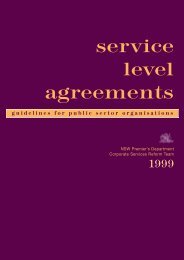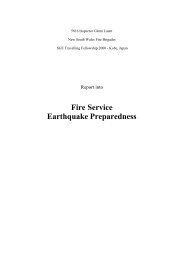Identify and respond to children and young people at risk - NSW ...
Identify and respond to children and young people at risk - NSW ...
Identify and respond to children and young people at risk - NSW ...
Create successful ePaper yourself
Turn your PDF publications into a flip-book with our unique Google optimized e-Paper software.
Highlight the impact th<strong>at</strong> abuse <strong>and</strong> neglect can have on <strong>children</strong> <strong>and</strong><br />
<strong>young</strong> <strong>people</strong>’s short <strong>and</strong> long-term capacity <strong>to</strong>:<br />
Reach developmental miles<strong>to</strong>nes for physical <strong>and</strong> psychological development<br />
Develop the capacity <strong>to</strong> make <strong>and</strong> maintain close personal rel<strong>at</strong>ionships<br />
Meet community expect<strong>at</strong>ions for behaviour <strong>and</strong> community particip<strong>at</strong>ion<br />
Maintain personal stability (e.g. housing, rel<strong>at</strong>ionships)<br />
Find <strong>and</strong> keep employment<br />
Raise <strong>children</strong><br />
4. Acknowledge th<strong>at</strong> just because we are concerned about the presence<br />
of some <strong>risk</strong> fac<strong>to</strong>rs does not mean th<strong>at</strong> a child will have an adverse<br />
outcome.<br />
Individual <strong>children</strong> will show extraordinary resilience, or will benefit from the<br />
presence of protective fac<strong>to</strong>rs.<br />
We are still learning about the fac<strong>to</strong>rs th<strong>at</strong> are associ<strong>at</strong>ed with resilience, <strong>and</strong><br />
how we can promote resilience for <strong>children</strong> for whom protective fac<strong>to</strong>rs have not<br />
been n<strong>at</strong>urally present. However research has helped us identify some fac<strong>to</strong>rs<br />
th<strong>at</strong> are more likely <strong>to</strong> be associ<strong>at</strong>ed with adverse outcomes.<br />
Detailed lists of indica<strong>to</strong>rs are provided in the Appendices 2-6 of the<br />
Participants Manual.<br />
5. Justice Wood in his 2008 report identified th<strong>at</strong>:<br />
‘<strong>to</strong>o many reports are being made <strong>to</strong> the Department of Community Services<br />
(as Community Services was known <strong>at</strong> the time) which do not warrant the<br />
exercise of its considerable st<strong>at</strong>u<strong>to</strong>ry powers’.<br />
He recommended th<strong>at</strong> the threshold for reporting should be raised <strong>to</strong> ‘significant<br />
<strong>risk</strong> of harm’ <strong>and</strong> th<strong>at</strong> where concerns were below the threshold the focus<br />
should be on connecting families with services th<strong>at</strong> could assist them <strong>to</strong> address<br />
<strong>risk</strong>s, r<strong>at</strong>her than necessit<strong>at</strong>ing a st<strong>at</strong>u<strong>to</strong>ry response.<br />
6. Emphasise the validity of the concerns th<strong>at</strong> participants have raised<br />
about <strong>children</strong> on the butcher’s paper. The issue is not whether these<br />
indica<strong>to</strong>rs are relevant in identifying <strong>children</strong> <strong>and</strong> families, but<br />
identifying where there are valid concerns <strong>and</strong> where <strong>children</strong> <strong>and</strong><br />
families may benefit from assistance. The question is how best <strong>to</strong> assist<br />
<strong>children</strong> <strong>and</strong> families, <strong>and</strong> specifically whether th<strong>at</strong> assistance is given<br />
best through a st<strong>at</strong>u<strong>to</strong>ry legally m<strong>and</strong><strong>at</strong>ed organis<strong>at</strong>ion, or whether it is<br />
preferable for families <strong>to</strong> receive it on a voluntary basis, with a focus on<br />
meeting needs r<strong>at</strong>her than st<strong>at</strong>u<strong>to</strong>ry protection.<br />
Facilita<strong>to</strong>r’s notes:<br />
If time allows you could show the trigger segments ‘Pam’ or ‘Vince’ from<br />
the <strong>Identify</strong>ing <strong>and</strong> Responding <strong>to</strong> Risk of Harm DVD. It can be useful in<br />
making concrete connections about the long-term impact of<br />
maltre<strong>at</strong>ment on <strong>children</strong>.<br />
Keep Them Safe CHCCHILD401A – Facilita<strong>to</strong>r’s Manual<br />
© The <strong>NSW</strong> Technical <strong>and</strong> Further Educ<strong>at</strong>ion Commission<br />
(TAFE <strong>NSW</strong> – Industry Skills Unit, Meadowbank, 2010)<br />
50







